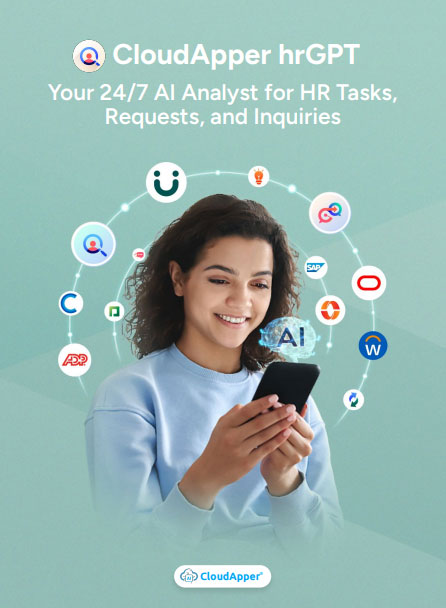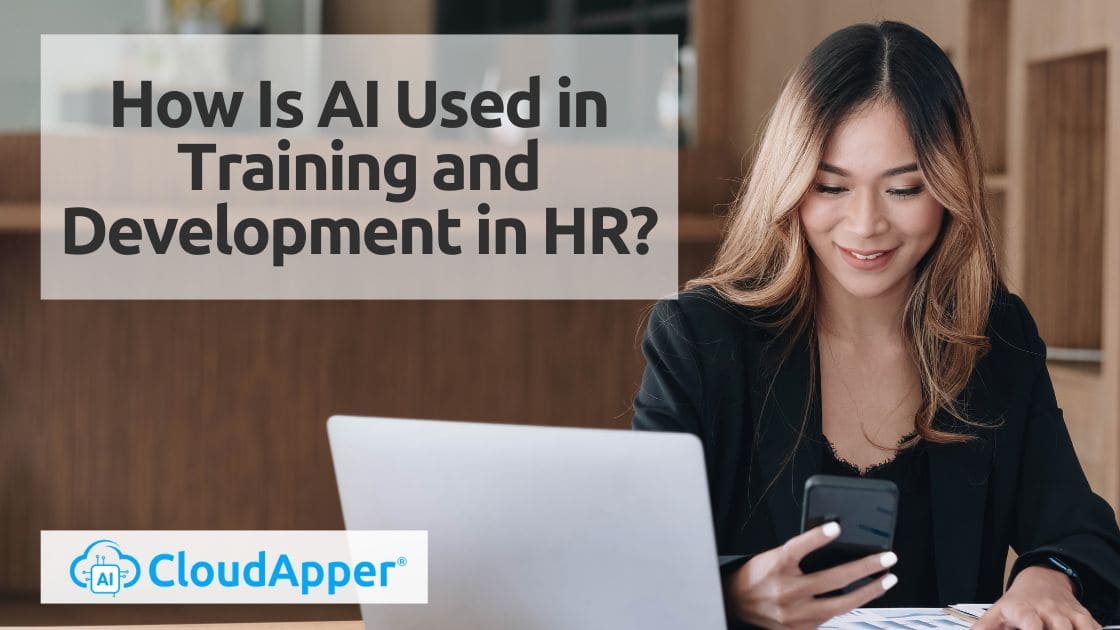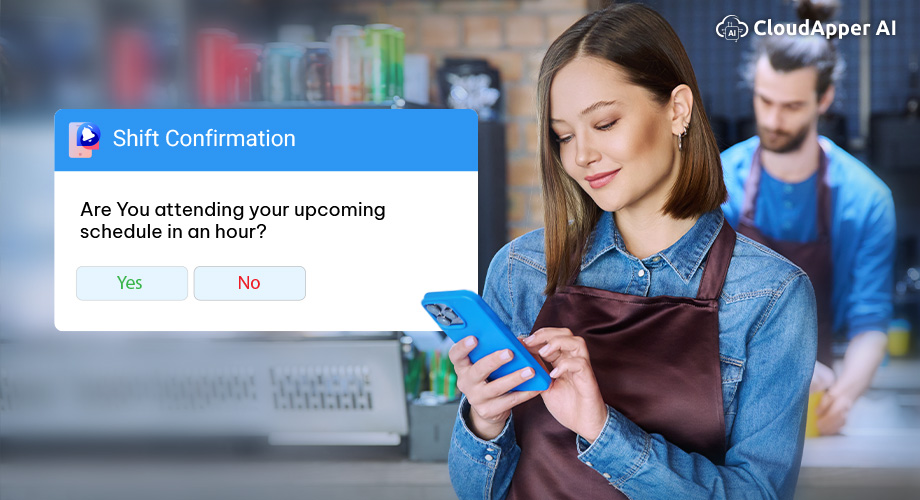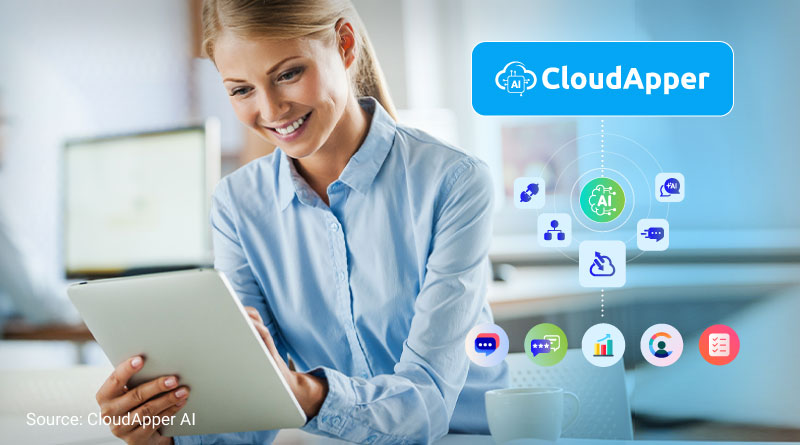Discover how AI, especially CloudApper's hrGPT, is revolutionizing HR training and development. AI suggests personalized learning paths for career growth, skill gap identification, content recommendations, and predictive analytics, leading to a more efficient and effective workforce.
Maintaining competitiveness in today’s ever-evolving corporate environment calls for a staff that is not just talented but also open to learning and change. Human resources (HR) experts know that investing in their staff’s professional growth is crucial to the company’s bottom line. However, conventional training methods can be tedious because of their inability to tailor instruction to each student’s specific requirements.
This is where AI comes in as a game-changing factor in human resources development and training. This article will examine how artificial intelligence (AI) is being utilized to transform training and development processes, with a focus on how CloudApper’s AI-powered hrGPT is at the forefront of this movement toward more effective, tailored, and engaging educational opportunities for everybody.
Understanding the Training and Development Landscape
Let’s first examine the difficulties that human resources confront in the training and development space before digging into the potential contributions of AI.
One-Size-Fits-All Approach: Traditional training methods are often impersonal and lack specificity. Individual preferences in learning, aptitude, or professional goals may not be taken into account.
Resource-Intensive: HR departments might waste a lot of time and energy if they try to plan, administer, and manage training programs manually.
Skill Gap Identification: Without evidence-based knowledge, it might be difficult to pinpoint where employees lack necessary skills and advise on effective training programs.
Content Management: Without evidence-based knowledge, it might be difficult to pinpoint where employees lack necessary skills and advise on effective training programs.
Measuring Effectiveness: Post-training assessments are commonly used to determine a program’s success, although they may not give accurate information.
Worker satisfaction with learning increased by 40% after the implementation of AI assitant for suggesting tailored learning paths.
The Role of AI in Training and Development
Artificial intelligence (AI) has several features that can help with these issues and improve the overall training and development sector. Let’s take a closer look at how AI is influencing human resources development programs:
1. Personalized Learning Pathways
CloudApper hrGPT uses artificial intelligence (AI) algorithms to asks questions about their job descriptions, qualifications, and goals. Using this information, the AI then proposes courses or personalized training programs available within the company.
An AI may recommend classes in leadership, project management, and strategic planning to a marketer who aspires to management.
2. Skill Gap Identification
Artificial intelligence systems can identify workers’ proficiency levels and pinpoint training needs in real time by asking questions. Human resources can utilize this information to provide tailored training courses to bridge skill gaps.
If an IT worker has to learn a new programming language for a project but doesn’t have the necessary background, AI can suggest suitable online training resources.
3. Content Recommendation
CloudApper hrGPT, like many other AI-powered systems, is excellent at recommending content. When workers use the system to find particular training materials or courses, AI will present them with immediate, pertinent recommendations.
If an employee wants to learn how to negotiate better, all they have to do is ask hrGPT for course suggestions, and it will provide them a hand-picked selection of negotiating classes from the library of accessible training.
Human resources has reported a reduction in administrative training management chores of 60%.
The CloudApper hrGPT Advantage
When it comes to HR training and development powered by AI, CloudApper’s hrGPT is where it’s at. Because of its user-friendly design and advanced artificial intelligence capabilities, it is revolutionizing the way businesses train their staff.
Real-World Impact: A Training Success Story
A mid-sized IT firm has adopted CloudApper hrGPT to elevate employee development. Here’s a taste of the effect it has in the real world:
- Improved Learning Efficiency: Worker satisfaction with learning increased by 40% after the implementation of AI assitant for suggesting tailored learning paths. They’d be able to hone in on exactly what required work.
- Skill Gap Reduction: The corporation was able to significantly narrow the disparities in expertise across its many divisions. Assessments of competence led by AI allowed for the pinpointing of problem areas, which were then addressed by carefully designed training courses.
- Data-Driven Decision Making: Data about employees’ abilities and educational development was readily available to HR. Strategic actions like workforce planning and talent development programs benefited greatly from this information.
- Real-Time Compliance: The use of AI improved the efficiency of compliance training. Compliance concerns were mitigated thanks to the system’s insistence that all staff members take compliance training.
- Time and Resource Savings: Human resources has reported a reduction in administrative training management chores of 60%. As a result, human resources were made available for greater strategic endeavors.
Conclusion: A Bright Future for HR Training and Development
Artificial intelligence (AI) is already being used in the HR training and development process. The hrGPT from CloudApper and other AI-driven platforms are revolutionizing the way businesses train their staff members.
For human resources experts, the future lies in incorporating AI into teaching and learning. Human resources professionals may use this information to build a team of employees that are not just skilled but also inspired to learn and change throughout time. Artificial intelligence (AI) is the future of human resources training and development, and it promises a brighter and more competent workforce.
What is CloudApper AI Platform?
CloudApper AI is an advanced platform that enables organizations to integrate AI into their existing enterprise systems effortlessly, without the need for technical expertise, costly development, or upgrading the underlying infrastructure. By transforming legacy systems into AI-capable solutions, CloudApper allows companies to harness the power of Generative AI quickly and efficiently. This approach has been successfully implemented with leading systems like UKG, Workday, Oracle, Paradox, Amazon AWS Bedrock and can be applied across various industries, helping businesses enhance productivity, automate processes, and gain deeper insights without the usual complexities. With CloudApper AI, you can start experiencing the transformative benefits of AI today. Learn More

CloudApper AI Solutions for HR



- Works with
- and more.
















